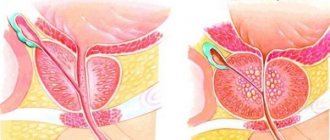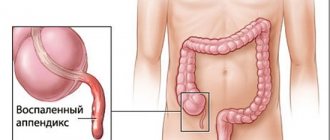Pain in the upper abdomen in the middle is a very dangerous symptom, which is a harbinger of the development of various pathologies and dangerous diseases.
Negative manifestations can form suddenly or increase gradually. Some go away in a short period of time, others annoy the patient over a long period. With increasing intensity and intensification of symptoms, you should contact a professional specialist. The patient must undergo a diagnosis of the body and find out why certain symptoms appeared. After passing diagnostic methods, appropriate treatment should be prescribed.
The upper abdomen hurts for various reasons. They are an indicator of all kinds of conditions. Diseases may manifest differently in each patient. Some patients experience more pain, while others experience less pain.
Since pain itself is considered a subjective feeling, relying on just one symptom is not recommended. It is impossible to make a correct diagnosis based only on the manifestations of pain. Therefore, it is necessary to take into account the individual characteristics of the body. It is also worth considering that diseases have a specific nature of pain.
Nature of pain
Pain in the center (middle) of the upper abdomen is divided into types of pain. They have corresponding symptoms. Patients with certain actions or changes in body position experience stomach pain in the upper middle. Not every person knows what to do and what actions to take.
- First of all, it is necessary to determine the location of the pain. To do this, you need to lie on your back and palpate the abdominal cavity. Using palpation, the most vulnerable painful spot is located.
- It is necessary to understand what preceded the onset of pain. It is necessary to establish why the negative consequences began to develop. It may be caused by excessive physical activity, nervous breakdowns, improperly selected diet, or consumption of alcoholic beverages.
- Next, the type of discomfort is determined. Depending on the symptoms that appear, pain is divided into several categories. Let's look at the most common ones.
It's a dull pain
The aching pain is not expressed by bright intensity. Therefore, most patients call such manifestations the most harmless. They can occur periodically or appear constantly.
It is worth considering that this type of pain indicates the initial development of the disease and negative changes in the body.
- Aching pain from above can be caused by poor circulation.
- It also manifests itself due to mechanical damage to internal organs. They can be obtained as a result of a fall from a height or a strong blow to the abdominal cavity.
- Aching pain occurs due to stretching of muscles and tendons of internal organs. The manifestation of unpleasant sensations is influenced by strong inflammatory processes.
- The cause may be dysfunction of the gastrointestinal tract. Such diseases include gastritis, duodenal ulcers, and infectious processes.
- The pain occurs due to inflammation of the pancreas.
- Development may be affected by diseases of the pelvic organs.
- Nerve endings in the spine may become pinched, causing pain in the upper abdomen.
- The cause may be pathologies of the central nervous system.
- Heart pain radiating upward to the abdominal cavity.
- Unpleasant sensations in the solar plexus, radiating into the abdominal cavity.
- Aching pain occurs due to infection of the abdominal cavity;
Acute pain
This type of discomfort is usually called “acute abdomen.” Acute sharp pain requires immediate medical attention. Such patients require surgical treatment.
Acute pain includes a complex of clinical signs that must be confirmed by instrumental or laboratory data. Acute pain can be life-threatening. They appear due to dangerous diseases, injuries or damage to the abdominal or pelvic organs.
Let's look at the most common causes of discomfort:
- Perforation of a stomach or duodenal ulcer;
- Myocardial infarction;
- Acute form of pancreatitis;
- Chronic stage of pancreatitis;
- Hepatic colic;
- Acute form of cholecystitis;
- Chronic stage of cholecystitis;
- Subphrenic abscess;
- Closed liver damage;
- Traumatic or spontaneous splenic ruptures;
- Development of pneumonia or pleurisy;
- Chronic diseases of the stomach and duodenum;
- Pancreas cancer;
- Liver diseases, which include:
- Organ enlargement;
- Chronic stage of hepatitis;
- Fatty liver degeneration;
- Cirrhosis of the liver;
- Development of neoplasms, metastases, tumors, parasitic cysts, abscesses, hematomas;
- Acute appendicitis;
Diseases and their symptoms in the presence of abdominal pain
A feeling of pain at the top may appear due to banal overeating, which, in turn, provokes blockage of blood vessels; a disease in the chronic stage of development. It appears with increased formation of gases. In these cases, the sensation of pain occurs quickly and goes away on its own within two hours.
If you feel pain in the right upper abdomen and in the navel area, this may mean that inflammation of the appendix or inflammation in the right part of the intestine is starting. If the first one is not responded to in time, the appendix may rupture, and without surgical intervention, death from blood poisoning is possible.
If your stomach hurts on the left, it means the problem is in the pancreas, stomach and colon. Pain on the right and above means that there is an inflammatory process in the gallbladder. If the pain is severe, consult a doctor immediately, otherwise the pain will only get worse.
Also, with inflammation of the gallbladder, the pain will make itself felt both on the left and in the middle of the abdomen, and may wander throughout the entire abdominal cavity. The presence of such pain may mean that there are problems with the duodenum. Pancreatitis may also be the cause.
If pain is felt on the upper right under the ribs, this indicates the presence of diseases of the pancreas, liver, right kidney, gall bladder, intestines, and right lung. Sharp pain under the ribs on the right is a sign of acute pancreatitis, which occurs when consuming fatty foods and large amounts of alcohol.
Attacks of pancreatitis occur in people whose diet is rich in fatty and fried foods, when drinking large amounts of alcohol, or with gallbladder diseases. Symptoms: profuse sweating, weakness, vomiting, nausea. The pain appears in the back, not in the upper right. Lying down becomes even more painful, improvement is observed while sitting and walking.
Inflammation of the intestines will make itself felt by a constant aching and mild sharp pain in the right upper abdomen. This state continues for 20 minutes and subsides, after a while it resumes. A characteristic symptom of intestinal inflammation is constipation or diarrhea, they alternate.
When pain occurs in and around the navel, it may be a symptom of a stomach ulcer, increased acidity, or gastritis. Gastritis of the stomach is associated with acute pain in the upper part, accompanied by nausea and dizziness. With diseases of the urinary and gall bladders, pain is felt in the upper abdomen around the navel.
Diseases of the lungs and heart can cause pain at the top and left side or at the top and right side. The pain is very sharp, the patient develops general weakness, he turns pale and his lips turn blue.
In the presence of a metabolic disorder, a process of irritation of the abdominal cavity receptors occurs. Sometimes this process is called a symptom of “acute abdomen”, when severe pain begins that is unbearable to endure. And with it, the muscles of the abdominal wall tense.
When a person has neurological diseases (for example, osteochondrosis), a process of compression of the spinal nerve roots occurs. Pain occurs, spreading along the nerve fibers.
If the upper abdomen hurts during pregnancy, this may be due to an enlarged uterus or the latter is compressed, as a result of which the gallbladder and liver are compressed. This leads to disruption of the bile secretion process, causing pain in the upper abdomen.
The cause of pain in the liver is bacterial or viral infections, diseases associated with the heart, while the liver becomes inflamed and swollen, its lining stretches. There may be worms in the organ. This leads not only to severe pain, but also to nausea and vomiting. Infection of the liver with viruses - viral hepatitis - in turn, is divided into three types: A, B, C.
Hepatitis A - infection occurs when eating food or water contaminated with the virus and containing E. coli.
Hepatitis B - the main method of infection is through the blood. It is possible to become infected through sexual intercourse or by using someone else's toothbrush. Hepatitis B is often found in drug addicts. It is also easy to become infected when using other people's manicure and pedicure equipment, or if they are not properly processed in a salon.
Hepatitis C - infection occurs through blood through contact with a sick person.
Toxic hepatitis is also possible, which occurs when the body is oversaturated with toxic substances that cause allergies. For example, a large dose of antibiotics, alcohol, household chemicals, contraceptives.
Get tested to rule out hepatitis. If you've had shellfish on your menu in the previous three weeks, get tested for hepatitis A. For hepatitis B, if you've had alcohol poisoning in the last three weeks or used a needle that was used to prick someone infected before you. Have you had a blood transfusion in the last two weeks? Hepatitis C is possible. And the most accurate sign of any type of hepatitis is yellowing of the skin and whites of the eyes, and the urine becomes brownish-red or red.
Features in men
Pain in men occurs when the prostate becomes inflamed. They can provoke the development of the acute stage of prostatitis, urethritis, ascending infections, sexual disorders, physical inactivity. The reasons may be:
- Interrupted sexual intercourse;
- Rare or violent sex life;
- Sedentary “office” lifestyle;
- Presence of chronic constipation;
- Drinking alcoholic beverages;
Pain may occur behind or above the pubis.
They radiate to the groin, sacrum, perineum, lower back and rectum. They may be accompanied by painful frequent urination. At the same time, a person’s body temperature may rise, weakness may develop, and performance may decrease.
What can be treated at home
In rare exceptions, if abdominal pain is mild, immediate medical attention is not required. These are cases: constipation, irritable bowel, heartburn, menstrual pain in women. However, the pain should not be constant and sharp. It is worth noting that if the patient knows about his own chronic illness, and the attending physician has already prescribed a certain treatment, the patient should not go to the hospital every time a painful symptom appears, because he already knows what medications to treat. If symptoms worsen or new ones appear, you should immediately seek help from specialists, because home conditions will not allow a number of additional examinations.
If stomach problems are not significant, and the pain is dull and aching, it is allowed to use over-the-counter painkillers.
Features in women
If it hurts in the upper abdomen, this may be a consequence of inflammatory processes in the internal reproductive organs - the uterus, tubes, ovaries. Unpleasant manifestations are felt in the upper or lower abdomen in the iliac regions. May be accompanied by intoxication syndrome in the form of:
- Chills;
- Weaknesses;
- Loss of appetite;
- Dizziness;
- Fever;
The localization of pain occurs above the womb, upper and lower abdomen.
Purulent discharge with blood clots that have an unpleasant odor is formed. Unpleasant sensations can radiate to the perineum, sacrum and lower back. Pathologies include:
- Intra-abdominal bleeding;
- Ovarian rupture;
- Ectopic or ectopic pregnancy;
The stomach hurts during critical days, after blows, falls, complications after a tubal abortion.
In what cases should you urgently see a doctor?
The patient should consult a professional specialist in the following cases:
- When the intensity of the pain defect increases;
- If there is a weak effect after taking medications;
- If there are symptoms of intoxication in the form of diarrhea, vomiting;
- With severe sharp or cutting pain during urination;
- If there are blood clots in the stool or urine;
- If your stomach hurts when moving or changing body position;
- If the patient's age is less than 10 and more than 65 years;
- If you have received severe abdominal injuries due to an impact, injury, fall from a height, or compression;
- In case of sudden acute pain that provokes awakening during sleep, insomnia;
- In the presence of pain accompanied by fever;
- With severe tension in the abdominal muscles, in which the middle of the abdominal cavity is hard and painful. There is a restriction in the respiratory movement of the abdomen;
- If it hurts in the upper abdomen, the pain syndrome is accompanied by rapid heartbeat;
The patient can consult a therapist, then contact a gastroenterologist, surgeon, allergist, neurologist, or oncologist. The choice of specialist depends on the developing disease.
Diagnostics
Pain in the center of the abdomen causes patients discomfort and unpleasant sensations, which disappear only after treatment. But before prescribing the necessary procedures, you need to undergo a diagnosis of the body. Diagnostics will help identify the causes of pain. It is very difficult to make a correct diagnosis, since today various diseases are known that cause identical pain syndrome.
- First of all, an initial examination should be carried out, during which simple manipulations are applied. The specialist can:
- Palpation, which reveals pain, the consistency of the liver and spleen. You can determine whether the pain intensifies when pressed.
- Visual examination, due to which increased gas formation, changes in skin tone, rashes and the manifestation of allergic reactions are determined.
- Auscultation, through which noise is heard using a stethoscope.
- Percussion, with the help of which tissue density and pain in the upper abdomen are detected.
- After the initial examination, the patient may be redirected for radiography. The study lasts no more than ten minutes. This research method involves passing X-ray microbeams through body tissue. The method is able to identify:
- Malignant tumors of the abdominal cavity;
- Formed stones located in the gallbladder or kidneys;
- Pathology of changes in the spine;
- Stomach ulcer;
- The presence of abscesses located in the abdominal cavity and liver;
- Diaphragmatic hernia;
- Developing pathologies in the spine;
Depending on the results of the examination, the patient may be prescribed:
- Computed tomography;
- Magnetic resonance imaging;
- Ultrasonography;
- Fibroesophagogastroduodenoscopy;
- Microbiological research methods, including:
- Microscopy;
- Cultural examination;
- Detection of antigens and antibodies;
- Polymerase chain reaction;
- Clinical and biochemical blood test;
- Clinical and biochemical urine analysis;
Diagnosis and treatment
Determining the cause of pain begins with a palpation examination of the abdomen to detect inflammation or swelling. The procedure is done by lightly pressing on various parts of the abdomen. To obtain the full amount of information, it is required that the patient correctly describe the intensity and nature of the pain, its distribution within the abdominal region. Afterwards, the attending physician prescribes the necessary additional examination. Moreover, a single procedure or a whole set of tests is permissible to exclude or confirm the presence of fractures, growths, swelling or ruptures.
Examinations required for diagnosis:
- Ultrasound – diagnoses a specific organ in the abdominal region.
- X-ray of the spine.
- Colonoscopy - examination is carried out in the inside of the colon and intestines.
- Endoscopy – search for abnormal formations and tumors in specific areas of the stomach or esophagus.
- General blood, urine, and stool tests for the presence of viruses, bacterial infections and parasites.
- Examination of the gastrointestinal tract using x-rays over the stomach for the presence of disorders such as ulcers, inflammation, neoplasms, etc.
- MRI.
What medications can be prescribed?
Traditional therapy can be medication or surgery. Tablets or surgery are prescribed depending on the developing disease. If there is pain in the upper abdomen, surgery is prescribed in the following cases:
- With peritonitis;
- Acute pancreatitis;
- Ulcer or cholecystitis, which are accompanied by internal bleeding;
- When cancer pathology is detected.
In other cases, drug therapy is prescribed.
Analgesics to relieve pain. They are available in the form of injections, tablets or syrups.
| Name | Description | Contraindications | Cost, rub |
| Analgin | Relieves biliary and renal colic. | Any blood diseases. | From 50 |
| Spasmalgon | Relieves mild to moderate pain. | Inhibition of bone marrow hematopoiesis. | From 125 |
Antipyretics that reduce high fever.
| Name | Description | Contraindications | Cost, rub |
| Paracetamol | Recommended for both adults and children. | Chronic alcoholism. | From 16 |
| Ibuprofen | Available in light pink tablets. | Stomach ulcer. | From 15 |
Bifidos and enzyme medications that normalize digestion.
| Name | Description | Contraindications | Cost, rub |
| Linex | Available in capsules. | Hypersensitivity. | From 267 |
| Mezim | Improves food digestion. | Acute stage of pancreatitis. | From 80 |
Antiemetics.
| Name | Description | Contraindications | Cost, rub |
| Torekan | Used for nausea and vomiting. | Depression. | From 100 |
| Aminazine | Used for hallucinatory-paranoid states. | Spinal cord diseases. | From 100 |
Anti-inflammatory drugs.
| Name | Description | Contraindications | Cost, rub |
| Aspirin | Relieves inflammation and pain. | Duodenal ulcer. | From 10 |
| Diclofenac | Relieves infectious and inflammatory diseases. | Bleeding from the gastrointestinal tract. | From 14 |
Means that normalize stool.
| Name | Description | Contraindications | Cost, rub |
| Lactusan | Available in the form of syrup and tablets. | Lactase deficiency. | From 150 |
| Maxilac | Available in capsule form. | Hypersensitivity. | From 413 |
Traditional methods
| Name of the disease | Name of folk remedy | Cooking recommendations | How to take it correctly |
| Gastritis or inflammation of the stomach | Agave juice with natural honey | 0.5 cups of freshly squeezed juice is mixed with 100 grams of natural honey. Stir until the lumps disappear. | Take one teaspoon three times a day. The dose should be taken fifteen minutes before meals. The course of treatment is one month. |
| Stomach or duodenal ulcer | Potato decoction | Jacket potatoes are boiled until tender. The resulting unsalted water is filtered and cooled. | Take 0.5 cups on an empty stomach three times a day. |
| Cholelithiasis | Rowan infusion | 50 grams of berries are poured with boiling water. Infuse for four hours. | Take one glass 7 minutes before meals three times a day. |
| Pancreatitis | Sprouted oats | Pour boiling water over oatmeal and simmer over low heat for two minutes. Cool and strain before use. | Take 20-30 milliliters throughout the day. |
| Crohn's disease | Sea buckthorn oil | Make your own or purchase from a pharmacy. | Take 50 milliliters daily on an empty stomach two hours before meals. |
Causes of pain in the upper abdomen
There are many factors that provoke pain. Symptoms may also indicate a foreign body in the human body or the development of a particular pathology.
Abdominal injuries
Even if there are no visible signs of injury (for example, hematoma), with blunt injuries, alarming symptoms may appear.
For example, such a condition could be a consequence of:
- Rib fracture.
- Splenic rupture. Most often, this type of injury results from a blow to the left hypochondrium. The pain is usually accompanied by very heavy bleeding, which can cause loss of consciousness.
- Liver rupture. The main consequence of such an injury is hemorrhage directly in the liver itself. When a cavity filled with blood forms, severe pain occurs.
Stomach ulcer
This is one of the most common causes of pain. The pathology is characterized by an increased level of acidity in the stomach. There are several stages in the development of gastric ulcer. As a rule, at the initial stage the patient is diagnosed with gastritis, which later turns into an ulcer.
Peptic ulcer is the most common gastrointestinal disease
An ulcer usually appears in a person against the background of:
- Poor nutrition. The provoking factor is the constant consumption of very hot, overcooked and spicy foods.
- Autoimmune mechanisms. The immune system begins to produce antibodies against the human body's own cells.
- Lack of vitamins. If a vitamin deficiency is diagnosed, this can cause gastritis.
- Alcoholism. When drinking alcohol in large quantities, the mucous membrane is damaged.
- Smoking. Negatively affects the functioning of the nervous system. Gastric juice begins to be produced too actively.
- Stress. With constant nervous tension, the body begins to actively synthesize special hormones. As a result, a failure occurs in metabolic processes. Damage to the mucous membranes occurs.
Pyloric stenosis
Spasms of this type often become a form of ulcer complication. As this pathology develops, the muscle located at the junction of the stomach and intestines begins to contract too much. Because of this, a narrowing of the lumen occurs. This leads to the fact that the bolus of food cannot pass normally through the stomach and move further through the intestines.
The problem may lie in the muscle itself, which constantly experiences spasms or against the background of the development of pyloric stenosis.
Symptoms for this diagnosis have the following features:
- pain becomes more intense and obvious after eating (not immediately, but after 1-2 hours);
- the pain is much more noticeable if a person eats solid foods or overeats;
- the pain is not constant, but periodic, of medium intensity;
- after lunch, an attack of vomiting often occurs;
- frequent belching and an unpleasant burning sensation reminiscent of heartburn appear.
Cholecystitis
As a rule, this disease is diagnosed when stones appear in this organ.
With cholecystitis, the pain syndrome is paroxysmal in nature. This symptomatology is called biliary colic. Pain may vary in intensity depending on the stage of the diagnosed pathology. Unpleasant pain is localized under the ribs on the right side.
Pancreatitis
“The upper abdomen hurts” - with this description of the symptoms, patients come to the doctor also for this disease. The condition may be sluggish. It occurs due to alcoholism or the formation of stones.
If a patient is diagnosed with acute pancreatitis, then the pain is predominantly localized around the navel. Also, discomfort may appear under the ribs closer to the back. With a sharp exacerbation of the pathology, hospitalization is required.
Pancreatitis can also occur in a chronic form. Then there are practically no alarming pain symptoms observed. From time to time the patient may complain of minor pain, but no serious attacks occur.
The most discomfort is felt when eating. As a rule, such symptoms disappear after the patient goes on a special diet and eats exclusively the foods recommended by the doctor.
Oncological diseases
It all depends on which organ the tumor begins to develop in. Based on this, oncological diseases are divided into several categories.
| Organ affected by cancer | Features of symptoms |
| Esophagus | The pain radiates more to the chest area. Even before the onset of pain, patients' swallowing function is impaired. |
| Stomach | A dull pain that becomes more intense as tissue is destroyed. Additionally, there may be problems with bowel movements. |
| Liver | As a rule, liver cancer develops as a complication of progressive cirrhosis. Patients also experience symptoms of jaundice, fever, and ascites (when too much fluid accumulates in the abdomen). |
| Gallbladder | It is a complication after cholelithiasis. Shortly after the first abdominal pain appears, you should pay attention to problems with stool and the appearance of signs of jaundice. |
| Pancreas | The pain is felt most in the area of the lower ribs. In this case, the unpleasant sensations disappear if the patient takes the fetal position. |
Spleen diseases
With the development of pathologies affecting this organ, pain is most strongly felt by the patient in the area under the ribs on the left side. The pain is acute, but quite rare. More often, patients complain not of pain, but of discomfort. This is due to an increase in the size of the internal organ.
If the patient experiences noticeable pain, then in this case there is a separate list of diseases affecting the spleen.
| Disease | Features of manifestation |
| Splenomegaly | The pain is localized under the ribs on the left side. The discomfort increases noticeably even with minor movements. |
| Diseases of hematological type | The enlargement of the spleen is caused by changes in blood composition. |
| Splenic rupture | Attacks of acute pain. They start suddenly. |
| Splenic infarction | Characterized by a sudden cessation of blood supply to the spleen. The tissues of the organ begin to quickly die, causing severe acute pain. |
| Spleen abscess | A large amount of pus accumulates around the organ. This also causes severe pain during finger examination (palpation). |
Liver diseases
If a person suffers from heart failure, infectious diseases, or chemical reagents enter the body that cause swelling of the liver, then intense and prolonged nagging pain may appear. It is noteworthy that the pain seems to come from within. At the same time, patients complain of a constant feeling of discomfort.
Stones may form in the liver. The organ may begin to malfunction or suffer from infection. All this also provokes pain. Additionally, patients constantly complain of increased sweating, vomiting and nausea.
Spinal diseases
If you have pain in the upper abdomen, you need to take into account that the organs of this cavity are very close to the spinal cord. Therefore, any diseases affecting the spine can also manifest themselves in a similar way. But pain due to spinal pathologies is rarely intense. As a rule, these are long-lasting, dull pains. Relief occurs when the posture changes.
Arachnoiditis of the thoracic spine causes pain in the upper abdomen
Similar symptoms are often found with osteochondrosis, minor and more serious back injuries, spinal tumors and arachnoiditis.
Myocardial infarction
We are talking about the death of a separate segment of the heart muscle. Typically, in this case, patients experience severe pain in the chest area. However, with an infarction of the posterior wall, which is in contact with the diaphragm, so-called atypical pain may appear. In this case, the discomfort is localized a little lower, in the upper abdomen.
Additional symptoms include vomiting, but there are no other manifestations of gastrointestinal problems. Additionally, patients pay attention to the appearance of severe shortness of breath, increased sweating, and increased heart rate.
Other possible diseases
“Upper abdomen hurts” is a fairly general description of the symptoms. A similar syndrome can occur in a variety of conditions.
| Disease | Features of manifestation |
| Hepatitis | Relatively tolerable pain, which is more like a feeling of discomfort under the ribs on the right side. At the moment of turning the body, the pain becomes acute. Symptoms also increase with exercise. |
| Peritonitis | Intense and prolonged pain syndrome, accompanied by constant tension of the abdominal muscles. Patients also complain of constant nausea and problems with bowel movements. |
| Porphyria | Pain in the form of sudden attacks. They are also localized in the upper part of the peritoneum. |
A person can encounter such pathologies or conditions at any age.











